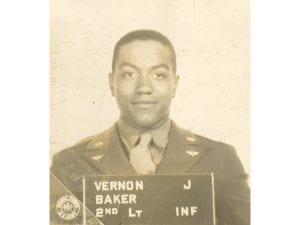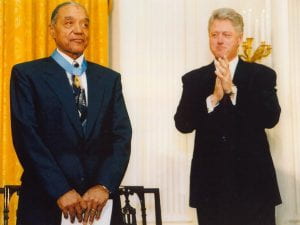Vernon Joseph Baker (1919-2010), is one of the seven Black soldiers of World War II to receive a Medal of Honor. Vernon Baker was born on December 17, 1919, in Cheyenne, Wyoming, but later moved with his grandparents to Clarinda, Iowa. In 1937, amidst the Great Depression, Baker graduated from high school, and for several years afterward, worked as a busser and a railroad porter. “I couldn’t find a job,” Baker said in an interview with the National World War II Museum, “I hated it…I had come in contact with many people who had no regard for a Black face.”
Eventually, his sister convinced him to enlist in the army, but in April 1941, he was denied because of his race. In June, Baker attempted to enlist with a different recruiter, who accepted him. Baker was sent to Camp Wolters, Texas, for basic training and eventually nominated to attend officer candidate school in October 1942 at Fort Benning, Georgia. Despite the racial discrimination he experienced in the military, Baker explained that he continued to serve in the U.S. military because “it was the only country I had…and then again, I’m defending people that don’t like me, but I had nowhere else to go.” He was commissioned as a Second Lieutenant and became a weapons platoon leader in the 370th Infantry Regiment of the 92nd Infantry Division, the only all-Black division that participated in combat in Europe during World War II. In April 1944, Lt. Baker and the rest of the 92nd Infantry Division learned they would join the Fifth U.S. Army in Italy.

I wasn’t shipping over there to get my a** shot off. I was determined I was going to survive.” – Vernon Joseph Baker
By this point, Allied forces had already gained territory in southern Europe. In the summer of 1943, Allied forces took the island of Sicily in Operation Husky and by September 1943, Allied forces successfully invaded the Italian mainland. The Allies continued to advance through Italy, capturing the city of Naples in October 1943, and eventually capturing Rome on June 4th, 1944, just two days before the Allied invasion of Normandy off the coast of France.


In August 1944, as the Allies continued pushing through France and Italy, the Germans decided to build the Gothic line, a defensive line in northern Italy stretching from La Spezia/Massa on the west coast to the Adriatic Sea on the east coast. At the same time, the 370th Infantry and other regiments of the 92nd Division arrived in Italy to join the Fifth Army, which lost veteran divisions amounting to about half its strength. By September, the 92nd Division was stationed near the Gothic Line in Northern Italy. The Rugged terrain of Northern Italy provided an advantageous defensive position for the Germans, and the 92nd Infantry faced heavy scrutiny, especially under a military leadership that held racist views, after failing to dislodge the enemy in the Serchio Valley in the fall of 1944.


However, by the end of 1944, German forces were especially weak, and the Allies planned for a spring offensive to drive the Germans out of Italy. Named Operation Second Wind, the 92nd Infantry Division was slated to attack the enemy’s right flank against Massa, with the hope that it would force the Germans to commit to local reserves. Lt. Baker and the 370th Infantry would push through the hills and mountains near Massa, along with the 442nd Japanese-American Regiment, which would move into line on the right. On the morning of April 5th, 1945, Allied artillery and planes began to attack the German position near Massa, and Operation Second Wind began.


The advance of Lt. Baker’s C Company was so rapid that it had reached a point nearly 3,000 yards behind the enemy’s most forward position and was east of Castle Aghinolfi, the strongly defended enemy observation post.
I heard explosions behind me and I said: Oh my god we outran our artillery. But that wasn’t artillery we heard. That was my men stepping on mines” – Vernon Joseph Baker
Enemy mines and machine gun fire inflicted heavy damage on C Company, and they retreated from the hill after suffering major casualties, including, according to Baker, desertion from C Company’s commanding officer, Captain John Runyun. “No orders from nobody…No reinforcements. No re-supply. Our artillery had stopped; we had no observer, no radio.” Although Baker and Company C had to retreat during the operation, Lt. Baker killed 9 enemy soldiers and took out three machine gun nests, an observer post, and a dugout.

By April 8th, the Germans had withdrawn and on April 10th, the 92nd Division entered Massa. The fall of Massa opened a wound in German defenses and led to their ultimate defeat in Italy. The 92nd division continued its relentless attack, sweeping 100 miles to the north and west until enemy forces surrendered. After Massa came La Spezia, other towns across the coast, and then finally Genoa on April 27, 1945. On May 7th, 1945, Germany surrendered to Allied forces.


On July 4, 1945, Lt. Baker was awarded the Distinguished Service Cross, the Army’s second-highest award for bravery, for his actions. When asked whether he felt that he deserved the Medal of Honor, he said he “never thought about getting it.”
Medal of Honor never even crossed my mind. I got the DSC, I did my job, and that was it…let’s get on with our lives.” – Vernon Joseph Baker
In the early 1990s, the Department of Defense, along with researchers at Shaw University, a historically Black college in Raleigh, North Carolina, began to study why no African Americans were awarded the Medal of Honor during World War II. The report found no official documents proving that Black soldiers were discriminated against in decisions to award the medal, but concluded that a climate of racism had prevented the recognition of their deeds. Military historians gave the Army the names of 10 Black servicemen who they believed should have been considered for the Medal of Honor. The Army board, looking at their files with all references to race deleted, decided that seven of these men, including Baker, deserved to be cited for bravery “above and beyond the call of duty.” On January 13, 1997, President Bill Clinton awarded the Medal of Honor to Baker and the six others, although Baker was the only one alive to receive it. Reflecting on this moment, Baker said: “I wish there were 19 men there sitting behind me. They are the ones who should have been there.”

Baker’s Medal of Honor citation reads:
For conspicuous gallantry and intrepidity at the risk of his life above and beyond the call of duty: First Lieutenant Vernon J. Baker distinguished himself by extraordinary heroism in action on 5 and 6 April 1945. At 0500 hours on 5 April 1945, Lieutenant Baker advanced at the head of his weapons platoon, along with Company C’s three rifle platoons, towards their objective; Castle Aghinolfi – a German mountain strong point on the high ground just east of the coastal highway and about two miles from the 370th infantry Regiment’s line of departure. Moving more rapidly than the rest of the company, Lieutenant Baker and about 25 men reached the south side of a draw some 250 yards from the castle within two hours. In reconnoitering for a suitable position to set up a machine gun, Lieutenant Baker observed two cylindrical objects pointing out of a slit in a mount at the edge of a hill. Crawling up and under the opening, he stuck his M-1 into the slit and emptied the clip, killing the observation post’s two occupants. Moving to another position in the same area, Lieutenant Baker stumbled upon a well-camouflaged machine gun nest, the crew of which was eating breakfast. He shot and killed both enemy soldiers. After Captain John F. Runyon, Company C’s Commander joined the group, a German soldier appeared from the draw and hurled a grenade which failed to explode. Lieutenant Baker shot the enemy soldier twice as he tried to flee. Lieutenant Baker then went down into the draw alone. There he blasted open the concealed entrance of another dugout with a hand grenade, shot one German soldier who emerged after the explosion, tossed another grenade into the dugout and entered firing his sub-machine gun, killing two more Germans. As Lieutenant Baker climbed back out of the draw, enemy machine gun and mortar fire began to inflict heavy casualties among the group of 25 soldiers, killing or wounding about two-thirds of them. When expected reinforcements did not arrive, Captain Runyon ordered a withdrawal in two groups. Lieutenant Baker volunteered to cover the withdrawal of the first group, which consisted mostly of walking wounded, and to remain to assist in the evacuation of the more seriously wounded. During the second group’s withdrawal, Lieutenant Baker, supported by covering fire from one of his platoon members, destroyed two machine gun positions (previously bypassed during the assault) with hand grenades. In all, Lieutenant Baker accounted for nine enemy dead soldiers, elimination of three machine gun positions, an observation post, and a dugout. On the following night, Lieutenant Baker voluntarily led a battalion advance through enemy mine fields and heavy fire toward the division objective. Lieutenant Baker’s fighting spirit and daring leadership were an inspiration to his men and exemplify the highest traditions of the military service.”
Bibliography
Atkinson, Rick. The Day of Battle: The War in Sicily and Italy, 1943-1944. Henry Holt and Co., 2008
Bennet, James. “Medals of Honor Awarded at Last to Black World War II Soldiers.” The New York Times, Jan. 14, 1997, www.nytimes.com/1997/01/14/us/medals-of-honor-awarded-at-last-to-black-world-war-ii-soldiers.html.
Bultman, Lori. “Remembering the Service of the Fifth Army’s 92nd Infantry Division.” U.S. Army, Feb. 18, 2021, https://www.army.mil/article/243460/remembering_the_service_of_the_fifth_armys_92nd_infantry_division
Converse, Elliott, et al. The Exclusion of Black Soldiers from The Medal of Honor in World War II: The Study Commissioned by the United States Army to Investigate Racial Bias in the Awarding of the Nation’s Highest Military Decoration. McFarland & Co., 2008.
Fisher, Ernest F. Cassino to the Alps. Center of Military History, U.S. Army, 1993.
Gibran, Daniel K. The 92nd Infantry Division and the Italian Campaign in World War II. McFarland & Co, 2001.
Goldstein, Richard. “Vernon Baker, Belated Medal of Honor Recipient, Dies at 90.” The New York Times, July 14 2010, www.nytimes.com/2010/07/15/us/15baker.html.
“Honor Deferred: Black Veterans and the Medal of Honor: The National WWII Museum: New Orleans.” The National WWII Museum | New Orleans, Jan. 31 2023, www.nationalww2museum.org/war/articles/honor-deferred-black-veterans-and-medal-honor.
Kershaw, Alex. Against All Odds: A True Story of Ultimate Courage and Survival in World War II. Dutton Caliber, 2022
Lee, Timothy. “42 maps that explain World War II.” Vox, 13 Nov. 2014, https://www.vox.com/2014/11/13/7148855/40-maps-that-explain-world-war-ii
Lee, Ulysses. The Employment of Negro Troops. Center of Military History, United States Army, 2001.
National Park Service. “Vernon Baker: Charles Young Buffalo Soldiers National Monument.” National Parks Service, 31 May, 2022, www.nps.gov/people/vernonbaker.htm.
Popa, Thomas, and John Mountcastle. “Po Valley 1945.” U.S. Army Center of Military History, https://history.army.mil/brochures/po/72-33.htm. Accessed May 8, 2023.
Shaughnessy, Larry. “Vernon Baker, Extraordinary Hero and Victim of Racism, Dies.” CNN, July 15, 2010, www.cnn.com/2010/US/07/15/medal.of.honor.winner.obit/index.html.
“Vernon Joseph Baker: World War II: U.S. Army: Medal of Honor Recipient.” Congressional Medal of Honor Society, www.cmohs.org/recipients/vernon-j-baker. Accessed May 8, 2023.
United States Military Academy at West Point. “Second World: European Theater.” United States Military Academy at West Point, https://www.westpoint.edu/academics/academic-departments/history/digital-history/atlases/world-war-two-europe. Accessed May 9, 2023
Unknown Interviewer, et al. Vernon Baker Collection. 1941. Personal Narrative. Retrieved from the Library of Congress, <www.loc.gov/item/afc2001001.89614/>.